Today’s workers are frazzled. Stressed. Running on fumes. And most likely, hungry.
With mounting pressures to meet deadlines and perform at work, more people are facing a time crunch — and in many cases, that means skipping lunch to try to power through their workloads. While American hustle culture is nothing new, as data from this year’s Lunch Report by ezCater revealed, missing meals during the workday is a real trend, and it’s worsening by the year.
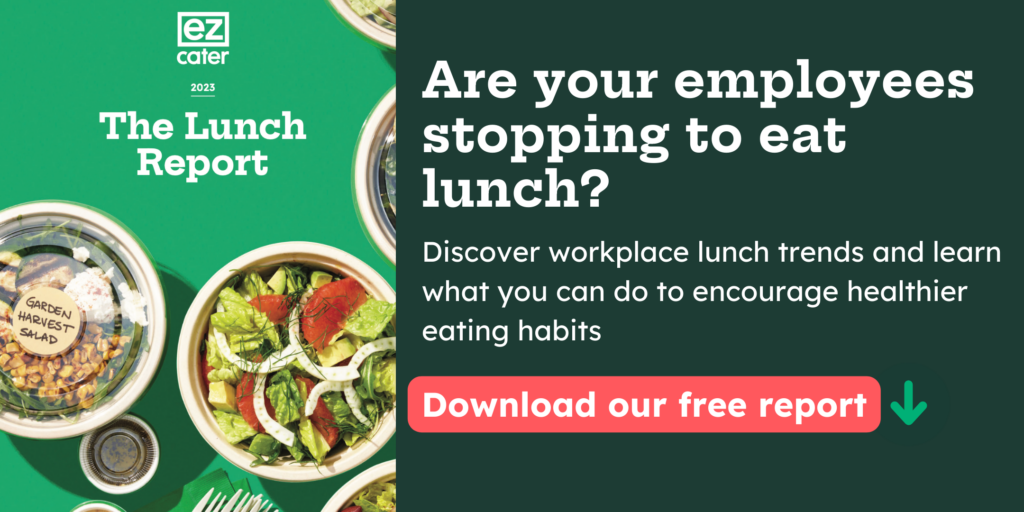
In the report — which surveyed 1,000 workers to learn how they eat lunch and the impact lunch has on their health, productivity, and overall happiness at work —the percentage of people who said they never take a lunch break is 40% higher than last year.
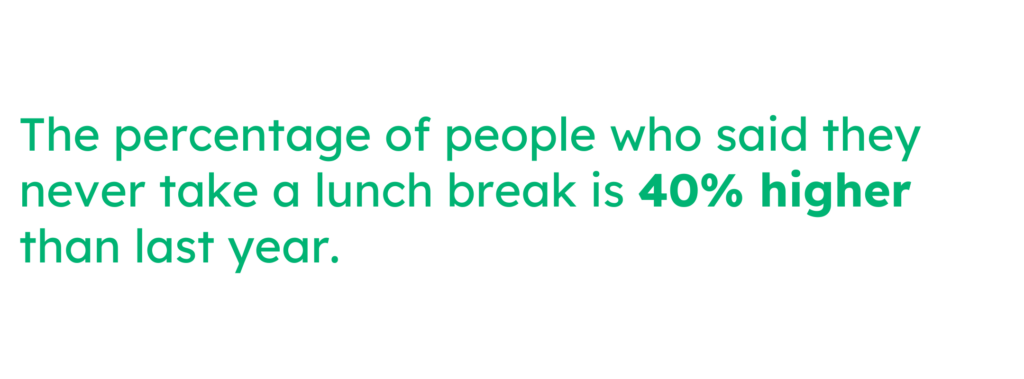
Employees shared that they miss lunch for different reasons, but mostly because they’re swamped with work, or because they worry that taking a break illustrates a poor work ethic.
When juxtaposed with the report’s other major finding — that employees are happier and less stressed when they take time to eat — employers should be concerned if members of their workforce are routinely opting out of lunchtime. In fact, the smart business strategy is to actively encourage employees to take regular lunch breaks.
We examined the survey data to pull out the key facts you need to know about employee lunch habits, as well as what’s motivating some to skip lunch, and why creating a lunch-friendly culture has big business benefits. Get ready to dig in.

Lunch at work has a perception problem
If employees skip lunch because they aren’t in the mood for the leftovers they brought from home or they had a really big breakfast, that’s one thing. But most people become lunch skippers because work is getting in the way. Here’s what they told us:
- 23% skip lunch so they can finish their work ASAP
- 22% fear they won’t have enough time to get work done if they stop to eat
- 20% blamed missing lunch on too many meetings
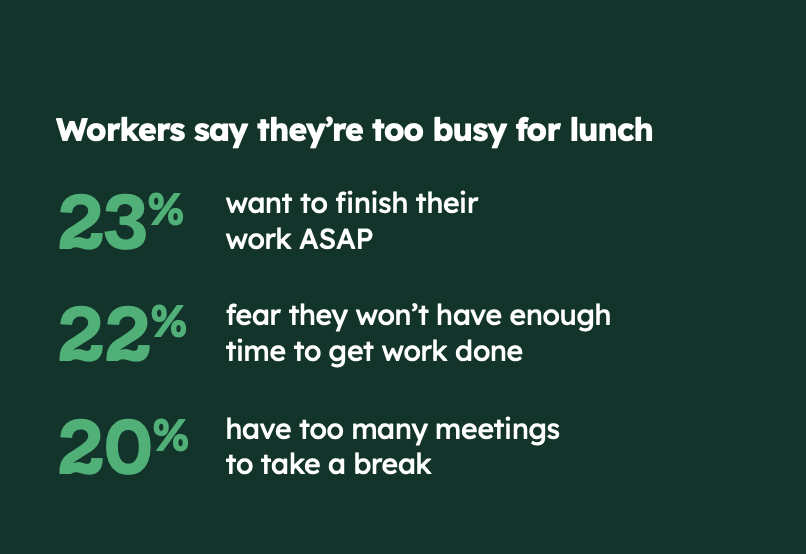
The youngest workers, Gen Z (who expressed the highest level of lunch love as compared to their older colleagues), were also the most likely to skip meals and take the shortest breaks because of work pressure. They’re also twice as likely to worry that their bosses will judge them for taking a lunch break.
Are you sensing a theme yet? Even if workers prefer to break for lunch, they feel like they can’t or that doing so is bad for their career. This notion is something that most employers who care about employee satisfaction and company morale would be dismayed to learn. Yet the survey reveals that many of today’s employees do feel this way, and as a result, are depriving themselves of the chance to refuel and recharge during the work day.
As far as what’s behind the steep year-over-year growth in people who regularly miss lunch, perhaps the rise in workplace monitoring and tracking software is putting more pressure on workers to meet goals and deadlines. APA’s 2023 Work in America survey found that compared with those who are not monitored, those who are monitored expressed a desire to keep to themselves at work (30% vs. 19%).
Whatever the reason, if taking a lunch break evokes feelings of guilt, shame, or worry, forward-thinking companies should take note and make an effort to turn things around.
Why Lunch Matters
When employees do take some time for themselves to eat something and step away from their work station, the benefits are clear — both for their personal well-being and for the company’s bottom line. Here’s what they say:
- It improves job performance > 78%
- Post-lunch, mental clarity increases > 53% (up from 47% last year)
- Lunching makes them happier > 53% (up 15%)
- Stress levels decline on days when they break > 50% (up 22%)
- They’re less burnt out > 48% (up 26%)
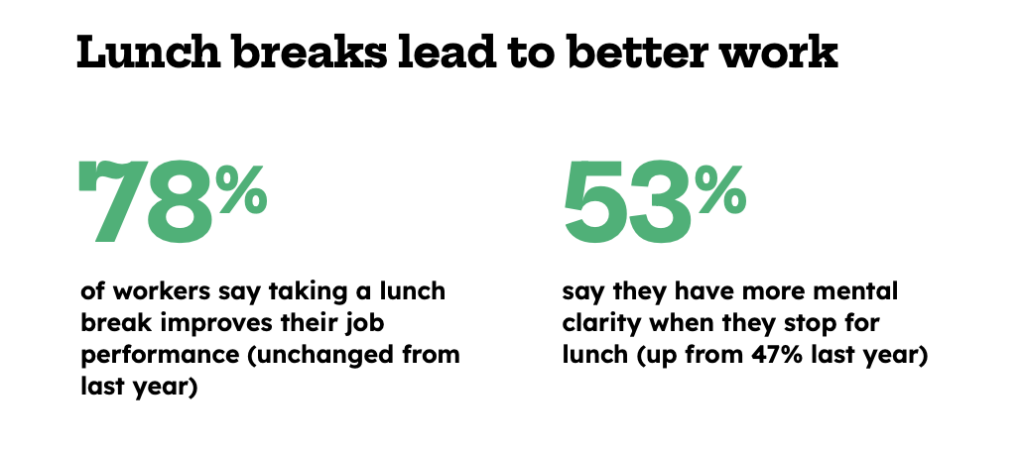
While the survey focused on how taking (or not taking) lunch breaks make employees feel, it’s important to not overlook the physical health consequences that missing mid-day meals can have.

How to Bring Back Work Lunch
To recap, lunch breaks bring out the best in your employees — and it’s important for both their mental and physical health. But employees feel like they can’t take meal breaks either because they have too much work to do, or because it makes them look bad. The result? Both workers and employers are unknowingly contributing to the cycle of workplace burnout.
Now here’s the good news: With a few simple tweaks, employers can break the cycle and create a workplace culture that prioritizes employees’ mental and physical well-being. Here are a few things you can start doing:
Show some lunch leadership
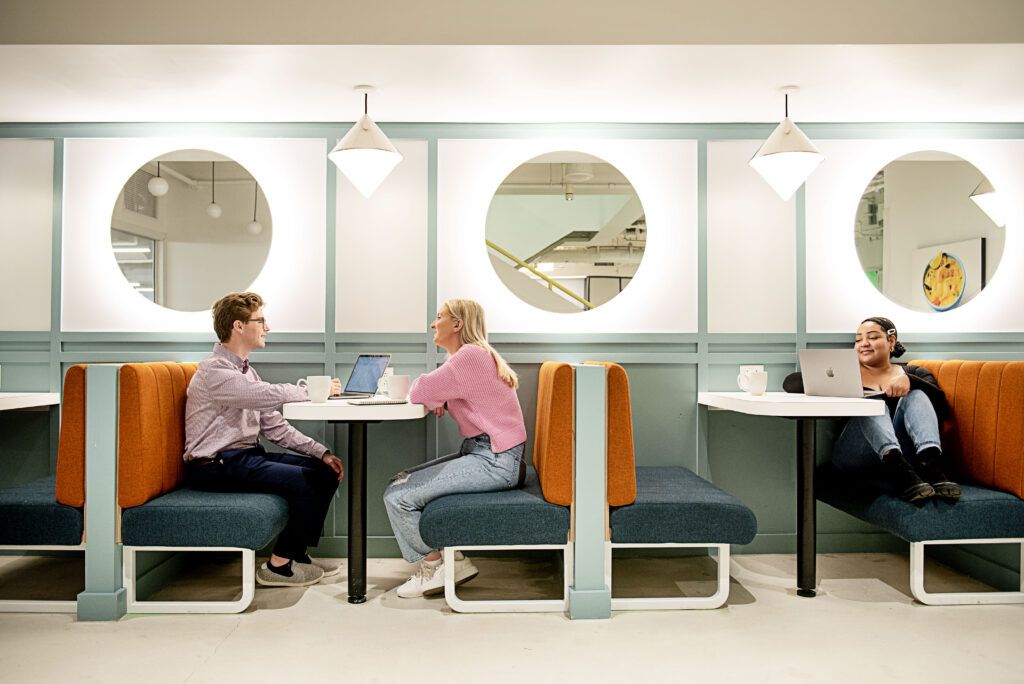
Try out a new policy like “no meeting Monday” or “take a break Thursday” to emphasize the benefits of taking breaks to eat and getting up from your desk. Get senior leaders to set the example by actually sitting down for lunch in the break room, or having managers send reminders to teams to take their lunch break. This can help dispel the idea that having lunch somehow means you’re not dedicated to your work.
Treat the staff
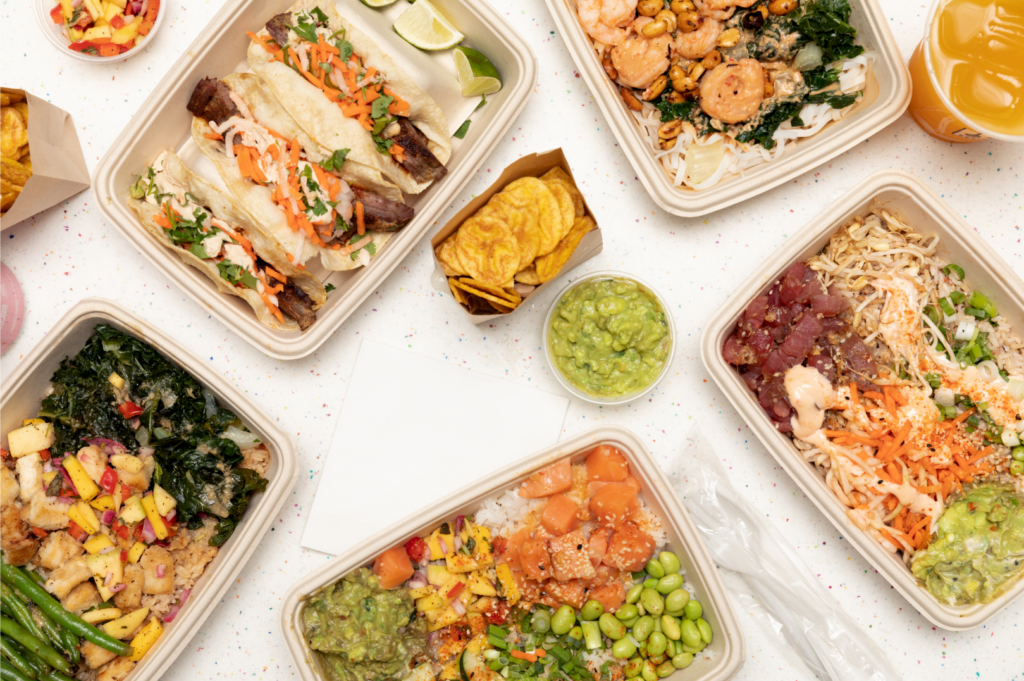
One surefire way to get your employees back into a lunch groove is to offer them a free meal. Subsidizing lunch for employees once or twice a week is not only a low-cost way to show worker appreciation, but it comes with the fringe benefit of increased productivity. By the way, workers say the #1 best thing about employer-provided lunch is that they get to spend less money, making it a high-value perk that doesn’t cost companies much at all.
Tip: Relish by ezCater lets you set up recurring meal plans in a few clicks. You set the budget, and then workers get to choose their meals.
Use catering to make “in-office” days special

For companies with hybrid schedules, ezCater research shows that free food motivates workers to come in — especially younger generations. More than 8 in 10 Gen Z workers agreed that food was an on-site motivator, while 67% of Millennials said the same.
Incorporate lunch into other staff activities

From “lunch and learns” to catered staff meetings to employee celebrations, team gatherings around food encourages facetime, collaboration, and camaraderie. It might even inspire colleagues to form a lunch bunch that dines together on the regular.
Pushing your employees to take lunch breaks is not only a nice thing to do for them, but it’s good for your bottom line. When workers are happier, less stressed, more productive, and can think clearly, their work output will be all the better. And, if you can sweeten the lunch pot by offering free employee meals, workers will feel even more valued — and well-fed!
Download ezCater’s 2023 Lunch Report








